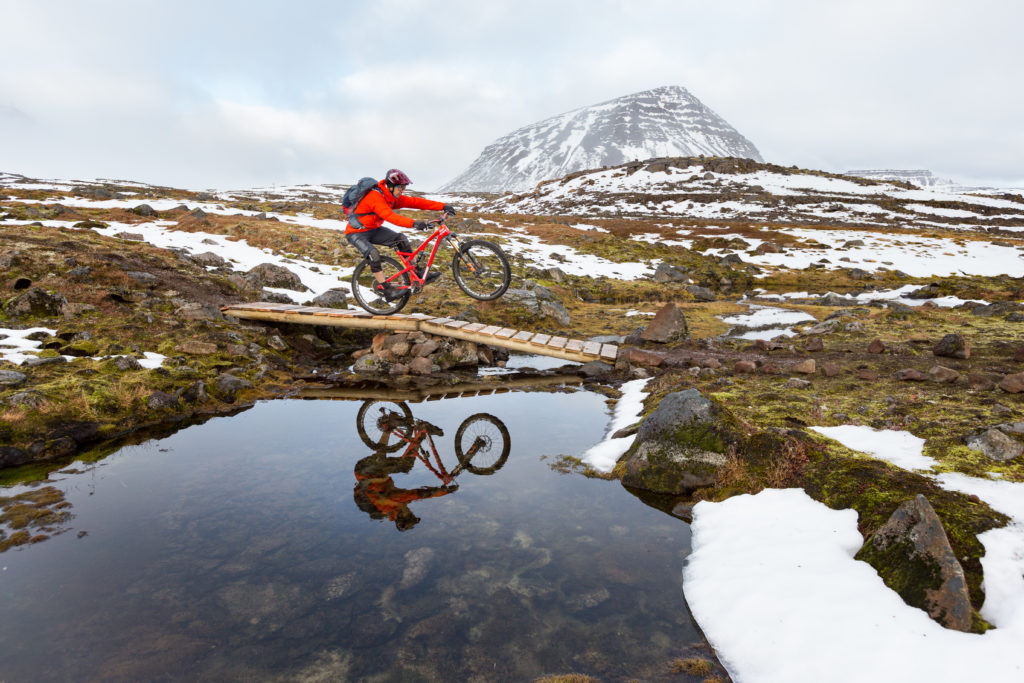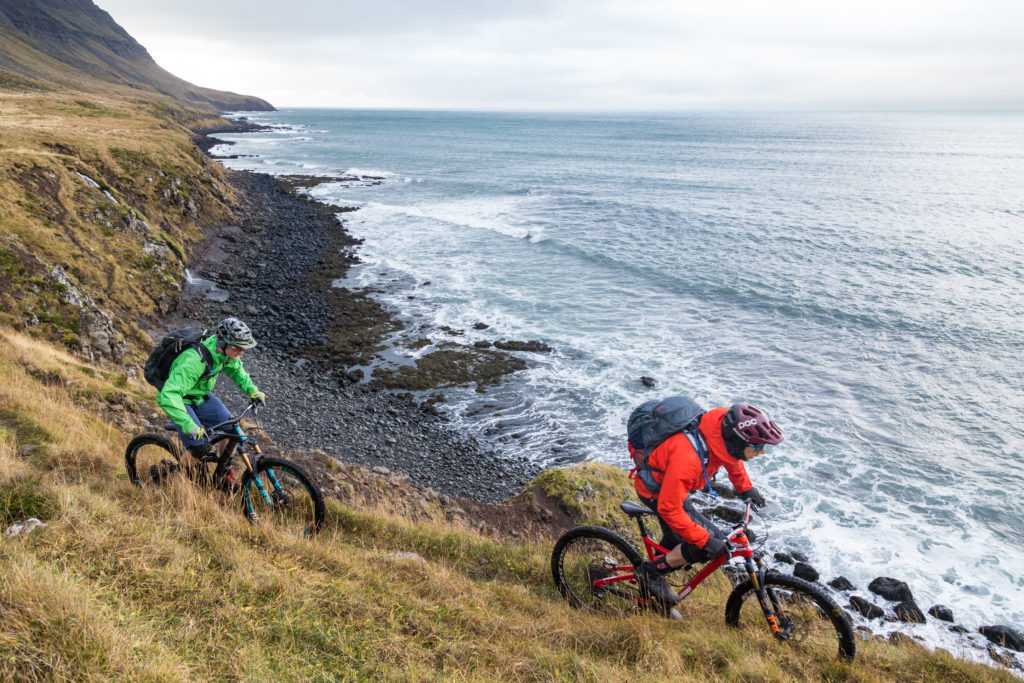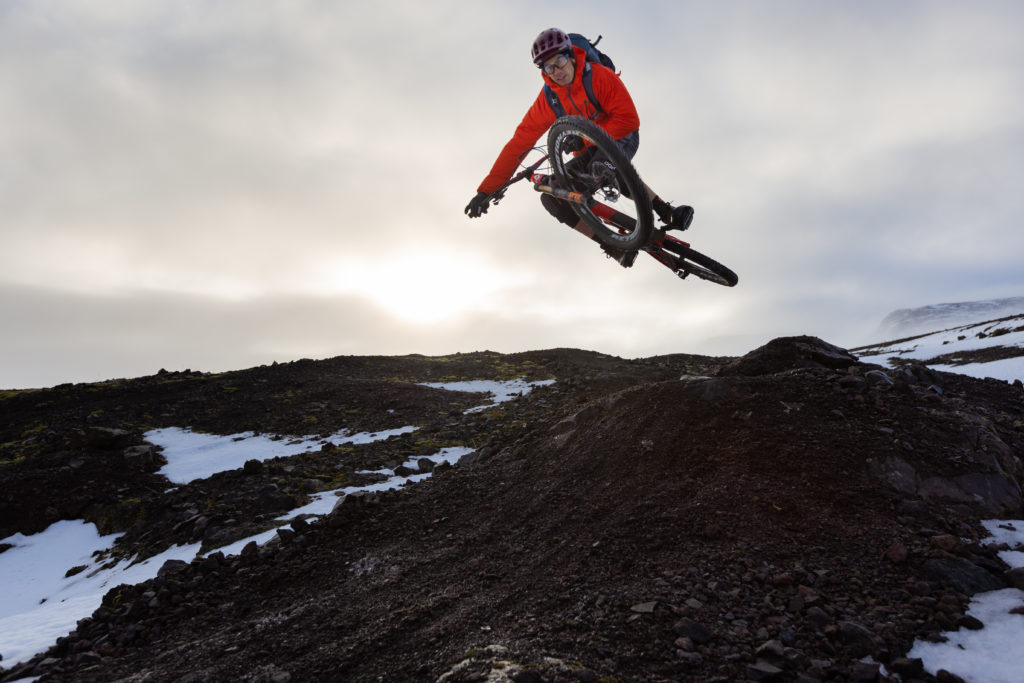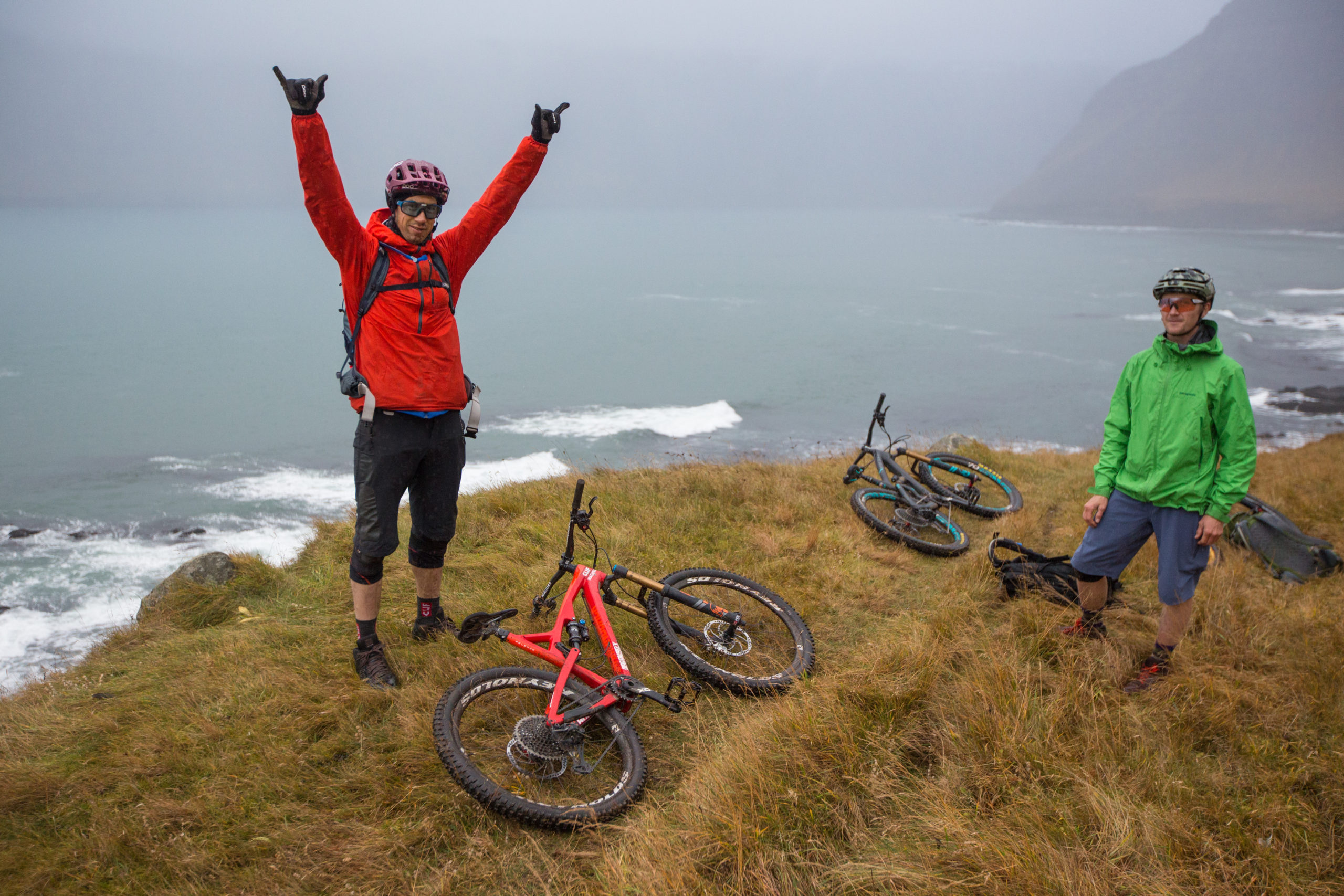
After a morning spent slamming my pedals into the muddy sides of our “trail,” repeatedly jerking to a stop mid-stroke, I’m beat.
These crisscrossing sheep paths looked so promising from a distance, but each trough formed by tiny hooves is just too narrow for a bike. Rain splatters against my glasses as I take a minute, lying on the spongy moss carpeting the valley floor and wishing a trail would magically appear and make this whole exploratory bike trip worth it.
Steely blue water foams against volcanic cliffs far below while a high plateau towers into the clouds above us, radiant with green lichen, tufts of golden grass and shiny blueberries. An early fall sunset glows through hazy fog, casting long shadows across the stark splendor of Iceland’s West Fjords. By all accounts, it’s beautiful. But a mountain biking destination? I’m not so sure.
Two days earlier, our 20-seater prop plane dipped beneath thick storm clouds, zooming toward basalt cliffs dropping 2,000 feet down to a dark indigo harbor bustling with activity. After the short flight from Reykjavik, the airplane banked a U-turn at the end of a narrow valley and we touched down on the single, questionably short, ocean-side runway of the Ísafjör∂ur airport, the largest town and hub of the remote, sparsely populated West Fjords region.
My friend Vidar Kristinsson met us at the baggage carousel with a huge smile. His looks identify him as a local—light oceanic eyes and a vibrant red beard, a modern-day Viking. “Welcome!” he said as he helped shuffle our baggage to the parking lot. After jamming three bike bags and gear into his Subaru, we piled in for the short drive to town.

The West Fjords are home to some of the most isolated communities in the nation, where small towns are scattered across 9,000 square miles surrounded by a jagged North Atlantic coastline. The frigid ocean reaches inland by way of deep, glacial-carved fjords and the rocky, sparsely vegetated landscape is scattered with wind-battered homesteads once inhabited by hardy farmers whose Viking ancestors settled the land 1,000 years ago.
While the flight from the capital of Reykjavik took only 40 minutes, driving requires five hours on winding, partially paved backroads. The region’s small population of 6,870 has been shrinking since the 1980s—when a seafood industry conglomeration bought out individual fisherman—stripping towns of their traditional jobs and income. But over the past few years, these remote towns have found themselves in a renaissance of sorts. They’ve discovered that the landscape that provided for their ancestors over the past 1,000 years has something to offer the new generation as well.
While outdoor recreation was never a thing in the past—being outside meant hard, often dangerous work on fishing boats in the stormy seas, plying the rocky ground with potatoes and carrots, or chasing sheep over the region’s fog-bound mountains— it’s definitely a thing of the future. And that’s why we’re here. Camilla Edwards, a recent West Fjords transplant, wrote me about a downhill trail that was being built near town. Vidar corroborated her story, saying the mountain bike scene was at an early stage, but he’d been putting in hours on an enduro trail above Ísafjör∂ur. He wrote, “I have many ideas. I promise you it will be a sufferfest and rocky. But also a lot of fun.”
The following morning, Vidar shakes his head with furrowed eyebrows. There’s no way all four bikes are fitting in his Subaru and small trailer. He’s offered to show us the town bike trail—the one he raved about a few months back via Facebook Messenger— but we need to get to the top first. Luckily, we’re sitting outside his grandfather’s old woodworking space, an olive-green Quonset Hut.
Carston Oliver and Eric Porter, my travel companions who are well-versed in bike transportation, suggest building a tailgate style side on his tiny trailer. Vidar eagerly pulls out wood scraps and a drill. Twenty minutes later, we’re off, and Vidar’s stoked on his new bike-mover. With the sport being so new to the West Fjords—we’re about to bike the town’s first purpose-built mountain bike trail, just now nearing completion—standardized racks are hard to come by.
As the sun creeps over the rolling green horizon, orange light spills across an ethereal landscape. The gravel road curves into the hills, following a gin-clear river tumbling over boulders. “I used to drive this road with my grandfather,” Vidar says. “Before tunnels connected neighboring towns, these roads were the only way.”
As we drive higher, a thick, chilly fog envelops the car. After parking at a nondescript fork in the road, Vidar pedals off through patches of snow and ice, disappearing into the clouds. A wooden stake marks the drop-in. The top is patchy with snowdrifts, but serpentine singletrack works its way through the tundra-like terrain, over dirt jumps, wood bridges spanning streams, and not the easiest sequence of rock rides. Triangular peaks punctuate the plateau, striped with bright white snow against the black volcanic rock. We pass a wheelbarrow and shovels before the trail takes a turn for the worse—a section that hasn’t quite been connected in the middle.

We pedal up the rock-strewn road to a cleft in the cliffs and start down an old postal route connecting Siglufjör∂ur to remote outposts along the coast. The trail was last used to deliver mail by horse in the ’70s and some sections are in rough shape, but it’s all there, just waiting for rejuvenation with people like Gestur’s exuberance to use and improve existing routes.
Pausing on an overlook where grassy hills roll down toward the vast indigo ocean, Gestur points at a notch in the distance, our singletrack weaving sinuously around lakes and boulder fields between here and there. Gestur and Carston take off at full speed down the loose trail, swooping around a banked corner before dropping from view. I take a minute to imagine the people who used to walk and ride this route—if they could see us now.
The last section of trail is smooth and fast, dipping into gullies with quick turns before popping out for another stunning ocean view. We exit onto a farm road and pedal to our shuttle car, Gestur excitedly talking about future plans between breaths. This year, he took bikers on a sailboat to access adventure rides in some of the wildest sections of the coast, now uninhabited, searching for routes from hundreds of years ago.
“I’m hoping to convince the town that we want quality over quantity of visitors,” Gestur explains aswe drive into town. “People who want to stay and recreate—skiing, biking, hiking. They contribute more to the community than cruise ships that dump 500 people to overrun town for an hour and leave.”
At each stop along our journey, we met hard-working, enthusiastic community advocates, all shepherding dreams of trail networks, sustainable food production, and viable economies centered in outdoor recreation. The plans are set in motion and, if all goes well, it seems recreational tourism might be the answer to replace the dwindling seafood trade and keep these small communities thriving in the decades to come.
As people like Óliver, Einar and Gestur continue developing specialized attractions and putting energy into local quality of life, what’s special about this place—the people, the traditions, the interaction with the natural environment—will live on. The very reasons these coastal settlements were such a challenging place to live for centuries—with extremely punishing weather and inhospitable mountainous terrain—may be exactly what saves them from obsolescence.
The full story can be found in the Spring 2019 issue of Freehub Magazine





